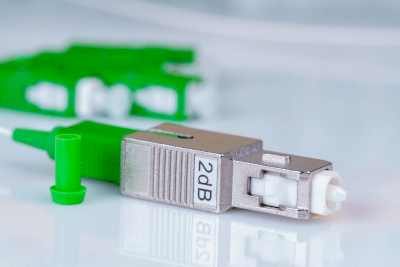What Is an Optical Attenuator?

An optical attenuator is a device that attenuates optical fiber signals to adjust them to an appropriate strength.
An optical attenuator is used to prevent differences in optical signal strength caused by differences in optical transmission distance from adversely affecting transmission equipment. Also to prevent damage to equipment due to saturation of the light-receiving element when the optical signal strength received by a light-receiving device is too strong.
There are two types of optical attenuators: a fixed optical attenuator, which has a fixed attenuation level, and a variable optical attenuator, which has an adjustable attenuation level.
Uses of Optical Attenuators
Optical attenuators are used to protect equipment by attenuating the intensity of optical signals when the amount of light received by the light-receiving element is saturated and may damage the equipment. This includes CATV systems where the output of the light source device is high or in optical fiber cables with short transmission distances.
They are also used to prevent variations in optical signal strength at the receiving end of wavelength division multiplexing (WDM) systems.
Optical attenuators are sometimes used to create a simulated communication environment when testing the transmission performance of an optical communication system or the error rate due to attenuation. By intentionally attenuating optical signals with optical attenuators, the maximum transmission performance of optical communication equipment can be measured.
Principle of Optical Attenuators
Optical attenuators are devices that are inserted between optical fibers to attenuate the intensity of optical signals. There are several methods to achieve attenuation of optical signals.
- Attenuation by Light Absorption: When an optical fiber contains transition metals such as iron, cobalt, or nickel, light energy is absorbed by these impurities. This phenomenon is exploited to use optical fibers intentionally doped with transition metals as optical attenuators.
- Attenuation by Magneto-Optic Effect: Light is attenuated using the Faraday effect, in which the deflection axis of the incident light rotates when a magnetic field is in the same straight line as the direction of light travel. In a magnetic field below the saturation magnetic field, the rotation angle of the deflection axis is proportional to the magnetic field. Therefore, the attenuation can be adjusted by the strength of the magnetic field.
- Attenuation by Air Gap: When a distance is set between optical fibers so that light passes through the air, the light energy is reduced at this air gap. This phenomenon is used to provide an air gap between connectors and used as optical attenuators. The attenuation can be adjusted by increasing or decreasing the air gap distance.
Other mechanical optical attenuator methods include bending an optical fiber or inserting a shield on the optical signal route.